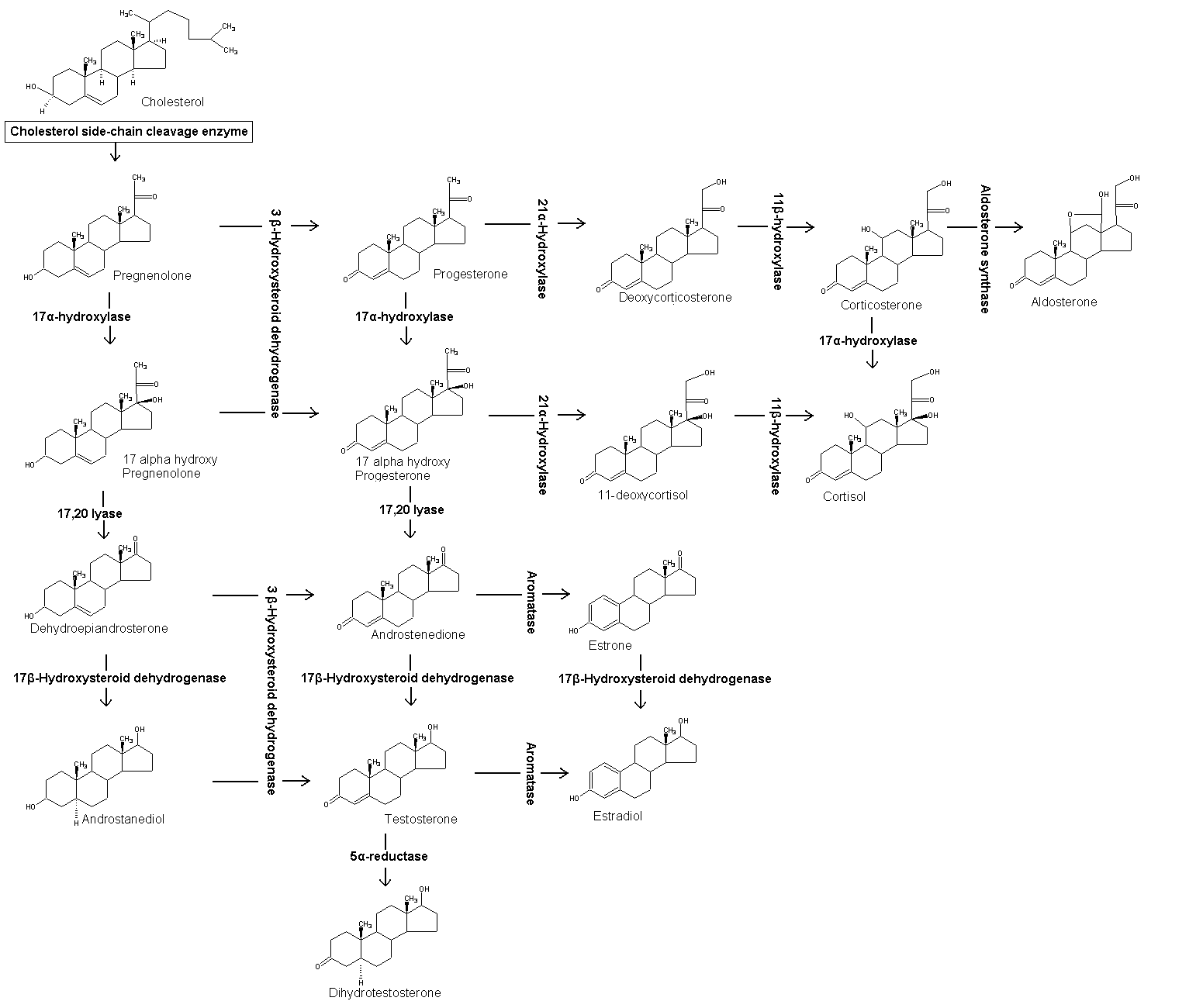17-Hydroxypregnenolone
| Pharmacokinetic data | |
|---|---|
| Metabolism | AdrenalGonads |
| Identifiers | |
| |
| CAS Number | |
| PubChem CID | |
| E number | {{#property:P628}} |
| ECHA InfoCard | {{#property:P2566}}Lua error in Module:EditAtWikidata at line 36: attempt to index field 'wikibase' (a nil value). |
| Chemical and physical data | |
| Formula | C21H32O3 |
| Molar mass | 332.48 g/mol |
| Melting point | 268 °C (514.4 °F) |
Overview
17-Hydroxypregnenolone (also 17-OH-pregnenolone and 17α-hydroxypregnenolone), is a C21 steroid that is obtained by hydroxylation of pregnenolone at the C17α position. This step is performed by the mitochondrial cytochrome P450 enzyme 17α-hydroxylase (CYP17A1) that is present in the adrenal and gonads. Peak levels are reached in humans at the end of puberty and then decline.[1] High levels are also achieved during pregnancy.
Prohormone
17-OH-pregnenolone is considered a prohormone in the formation of dehydroepiandrosterone (DHEA), itself a prohomone of the sex steroids.
This conversion is mediated by the enzyme 17,20 lyase . As such 17-OH-pregenolone represents an intermediary in the delta-5-pathway that leads from pregnenolone to DHEA. 17-hydroxypregneolone is also converted to 17-hydroxyprogesterone, a prohomone for glucocorticosteroids and androstenedione through the activity of 3-hydroxysteroid dehydrogenase.
Neurohormone
There is some evidence that 17-OH-pregnenolone may have activity as a neurohormone.[2]
Clinical use
Measurements of 17-OH-pregnenolone are useful in the diagnosis of certain forms of congenital adrenal hyperplasia.[3] In patients with congenital adrenal hyperplasia due to 3 beta-hydroxysteroid dehydrogenase deficiency 17-OH-pregnenolone is increased, while in patients with congenital adrenal hyperplasia due to 17 alpha-hydroxylase deficiency levels are low to absent.
See also
Congenital adrenal hyperplasia
Additional images
References
- ↑ Hill M, Lukac D, Lapcik O, Sulcova J, Hampl R, Pouzar V, Starka L. Age relationships and sex differences in serum levels of pregnenolone and 17-hydroxypregnenolone in healthy subjects. Clin Chem Lab Med. 1999 Apr;37(4):439-47. PMID 10369116
- ↑ Matsunaga M, Ukena K, Baulieu EE, Tsutsui K 7alpha-Hydroxypregnenolone acts as a neuronal activator to stimulate locomotor activity of breeding newts by means of the dopaminergic system. Proc Natl Acad Sci USA 2004 Dec 7;101(49):17282-7. PMID 15569930
- ↑ Riepe FG, Mahler P, Sippell, Partsch CJ. Longitudinal Study of Plasma Pregnenolone and 17-Hydroxypregnenolone in Full-Term and Preterm Neonates at Birth and during the Early Neonatal Period. The Journal of Clinical Endocrinology & Metabolism (2002) 87: 4301-4306 [1]
- Pages with script errors
- E number from Wikidata
- ECHA InfoCard ID from Wikidata
- Chemical articles with unknown parameter in Infobox drug
- Infobox drug articles without a structure image
- Articles without EBI source
- Chemical pages without ChemSpiderID
- Chemical pages without DrugBank identifier
- Articles without KEGG source
- Articles without InChI source
- Articles without UNII source
- Drugs missing an ATC code
- Drugs with no legal status
- Articles containing unverified chemical infoboxes
- Steroids
